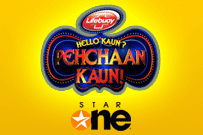Hello Kaun? Pehchaan Kaun
| Hallo Kaun? Pehchaan Kaun! | |
|---|---|
 A promotional image for Hello Kaun? Pehchaan Kaun! | |
| Country of origin | India |
| Original language(s) | Hindi |
| Release | |
| Original network | STAR One |
| Picture format | 480i (SDTV), |
| Original release | December 27, 2008 – April 5, 2009 |
| External links | |
| Website | |
Hello Kaun? Pehchaan Kaun! (English: Hello, who is it? You guess!) is a mimic show where the contestants mimic a famous celebrity. The show aired on STAR One on Saturdays at 9pm from December 27, 2008 to April 5, 2009. It is basically a mimicry contest. Every week eight artists are called upon to mimic well-known personalities (Johny Lever, Lal Krishna Advani, Manoj Kumar, Salman Khan etc.) and three best are chosen.
Overview
The show is hosted by well-known mimic Navin Prabhakar, who first shot to fame from his celebrated appearances in the show The Great Indian Laughter Challenge (season one).[1] Prabhakar mimics different celebrities in different episodes. He has mimicked well-known actors Jeetendra, Pran, Johnny Walker, Kamal Hasan, Sunil Dutt and several others. His own performance is arguably one of the best mimicries in the entire show. The show is innovative as the first a mimicry contest on Indian TV.
The show is judged by Chunky Pandey and Suresh Menon.[2]
The name of the show is a take on the catchphrase Pehchan Kaun (translation: Guess Who?) first popularized by Navin Prabhakar in his appearances in The Great Indian Laughter Challenge. After several dialogues of Sholay entered into the psyche and mannerisms of Indians, this is perhaps the first catchphrase to do so.
Being the pioneers in original comedy concepts, STAR One has come back with a new show Hello Kaun? Pehchaan Kaun. This show is the hunt for India’s best mimic. It's the hunt for that mimic who can walk the walk and talk the talk of a celebrity.
Contestants
- Rooesh Mirkap as Hrithik Roshan
- Vishal Gaba as Himmesh Reshammia
- Sumedh as Aamir Khan
- Rameshwar Mahajan as Johnny Lever
- Raja Sagoo as Salman Khan
- Sanjay Keni as Arshad Warsi
- Mukesh Patel as Dhoni
- Deepak Kumar as Ritesh Deshmukh
- KT as Ajay Devgan
- Abhin Sinha as Akshaye Khanna
- Sandeep as Jim Carrey
- Rajkumar Prashad as Baba Ramdev
- Rajat Bhaghat as Salmaan khan
- Siraj Khan as Laloo Yadav & Nana Patekar
Hosts
- Navin Prabhakar
- Aishwarya Sakhuja
Judges
See also
External links
References
- ↑ "Reality show contestants now turn anchors". Indian Express. Dec 29, 2008. Retrieved March 2, 2013.
- ↑ "Looking out for copycats". The Hindu. Jan 5, 2009. Retrieved March 2, 2013.